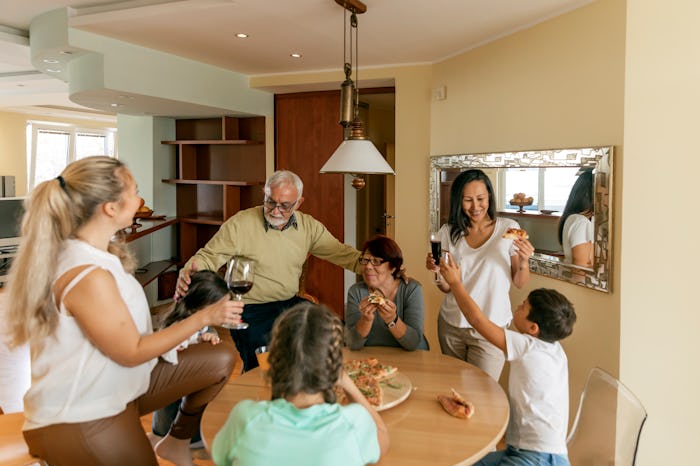Life

So What Exactly Is The "Bubble Concept" — & Could It Make Isolation Easier?
The term “bubble concept” sounds like a children’s television show (or maybe I’ve just seen too many episodes of Bubble Guppies), but it’s actually a social distancing strategy currently in use by several countries, including Canada and New Zealand. So what is the bubble concept? And could it work here in the United States?
The idea of the bubble concept is to "try to find a balance between physical safety and mental health," Dr. Gabriela Andujar Vazquez, infectious disease physician and associate hospital epidemiologist at Tufts Medical Center in Boston, tells Romper. Basically, it involves slowly and deliberately adding select people into your quarantine circle to help make isolation easier. If you've been quarantined with your immediate family, they're your "bubble," and if you agree to start seeing your next door neighbors or your sister's family, for example, then they become part of the bubble, too. The use of the word bubble in this sense originated with New Zealand's prime minister, Jacinda Ardern, who said to think of the people you need to see regularly and often as your bubble, and to act "as though you already have COVID-19" toward those not in your bubble (i.e. do not interact), The Atlantic reported. Bubbles should not include more than ten people, according to Andujar Vazquez.
The bubble still requires social isolation, albeit with a larger group, and the concept only works if everyone sticks to the plan. This means someone in the group can't decide one day that they're going for a walk with someone outside the bubble or get lax about wearing a mask. "Anyone can be the weakest link," Dr. Michael Schmidt, professor of microbiology and immunology at Medical School of South Carolina, tells Romper. "If you fail to doff properly, [or] forget hand hygiene at an opportune moment, the virus can sneak in and burst your bubble."
When you're at home with your bubble, you don't necessarily have to stay 6 feet apart (this is an impossible concept for many kids) or wear masks, but you do need to continue to "practice proper hand hygiene and cough etiquette," Andujar Vazquez says.
The formation of a bubble makes the rules re: the people you're allowed and not allowed to see very clear, and having a slightly wider social net may help with parenting anxiety and mental health. Forming a safe and contained bubble can "lighten the load on the primary family unit, and help everyone decompress a bit," Schmidt tells Romper. This can be especially helpful for single parents or people who have quarantined in complete solitude.
Elderly and immunocompromised people are at risk from both a physical and mental health standpoint, as many in this group have been alone for months. To have a grandparent or an immunocompromised person enter the bubble requires extra vigilance from all members when it comes to hand hygiene, cough etiquette, and transparency about feeling any symptoms, Andujar Vazquez says. These bubbles should contain less than 10 people, she adds, ideally all family members.
The goal of the bubble is to "remain COVID-19 free for as long as reasonably possible," Schmidt tells Romper. But bubbles can burst, so for the bubble concept to work, there has to be a high level of trust between the members and adherence to proper protocol. "Ideally, the bubble is most effective with routine testing. But when folks don’t follow the rules or the bubble expands, then the bubble bursts," Schmidt says.
Basically, that means that your group has to stay isolated (albeit isolated together) except for absolutely essential errands. It does not mean that your bubble grows to include the whole neighborhood or your bubble crew all goes to the park for a picnic. And there are still risks involved. "Unfortunately any contact will yield a certain degree of risk, but as long as we practice hand washing, covering our faces, and keeping a distance it can be minimized but not kept to zero," Dr. Niket Sonpal, a New York-based internist and gastroenterologist, tells Romper. "The concern with bubbles if it one person gets sick, it may affect the others."
Choosing your bubble can also feel like a middle school dance where someone is inevitably left out. As the Washington Post reported, "There are rules — and they are not for the commitment-phobic. Each household may join with only one other household. Both sides must agree — for better, for worse — to a mutually exclusive relationship. The decision applies to all members of both households. And it’s final." This means that grandparents with two adult children, for example, may be torn between which child they should bubble up with, and the one who isn't chosen will likely feel a little sting, if not full-blown rejection.
It's unrealistic think that people will isolate for "an indeterminate period of time," Andujar Vazquez says, and she adds that this level of social isolation can really take a toll on mental health. Bubbles allow people to deliberately add social interaction into their lives while still remaining relatively careful and safe. If there isn't some sort of protocol, there's the risk that people will grow tired of isolation and start seeing way too many people or socializing in groups well over ten.
If you're willing to have frank conversations with those who feel left out and you feel like your family's mental health could really suffer as a result of isolation, then a bubble might be the right option for you. Just remember, it's crucial to have trust and communication with those in your quarantine sphere, and continue to be rigorous about hand hygiene, wearing masks in public, and limiting interaction with others.
Experts:
Gabriela Andujar Vazquez, M.D., infectious disease physician and associate hospital epidemiologist at Tufts Medical Center
Michael G. Schmidt, M.D., professor of microbiology and immunology at Medical School of South Carolina
Niket Sonpal, M.D., New York-based internist and gastroenterologist